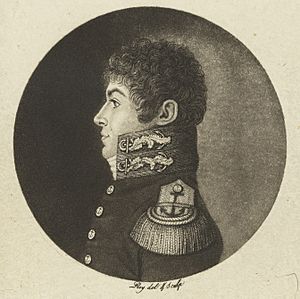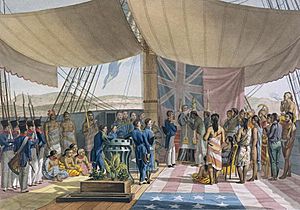Louis de Freycinet facts for kids
Louis Claude de Saulces de Freycinet (born August 7, 1779 – died August 18, 1841) was a brave officer in the French Navy. He is famous for sailing all the way around the world. In 1811, he also published the very first map that showed the complete coastline of Australia.
Contents
Biography of Louis de Freycinet
Louis-Claude de Saulces de Freycinet was born in Montélimar, France. He was often called Louis de Freycinet. He had three brothers: Louis-Henri, André-Charles, and Frédéric-Casimir. Louis-Claude was the second oldest of the four brothers.
In 1793, when he was 14, Louis joined the French Navy as a midshipman. He took part in several battles against the British navy.
Exploring Australia's Coastline
In 1800, Freycinet joined an important exploration trip. This expedition was led by Nicolas Baudin. Their mission was to explore the southern and southwestern coasts of Australia. Louis de Freycinet sailed on one of the ships, the Naturaliste. His brother, Louis-Henri de Freycinet, was also part of this journey.
Between 1802 and 1803, Freycinet became the captain of a smaller ship called the schooner Casuarina. He used this ship to carefully map parts of the Australian coastline. After this, he moved back to the Naturaliste and returned to France in 1804.
An English explorer named Matthew Flinders was held captive by the French on the island of Mauritius at this time. Because of this, some of his discoveries were accidentally claimed by the French expedition. New names were given to places already found by Flinders. However, this was later corrected.
In 1811, Baudin and Freycinet successfully published their own map of the Australian coastline. This was three years before Flinders could publish his map. Today, several places in Australia are named after Freycinet. These include Freycinet Estuary in Western Australia, Cape Freycinet, and the Freycinet Peninsula with Freycinet National Park in Tasmania.
After his return to Paris in 1805, the French government asked Freycinet to create maps and plans from the expedition. He also finished writing the story of the journey. This entire work was published as Voyage de découvertes aux terres australes.
Even some plants were named in his honor! The plant group Freycinetia and a Hawaiian tree called Santalum freycinetianum both carry his name.
Sailing Around the World on the Uranie
In 1817, Freycinet was given command of a ship called the Uranie. This ship was specially prepared for a new exploration voyage. Many scientists and artists joined him on the Uranie. These included Louis Isidore Duperrey, who studied water, and artists Jacques Arago and Adrien Taunay the Younger.
The Uranie sailed to Rio de Janeiro first. The crew took measurements using pendulums. They also gathered information about geography (the study of Earth's features), ethnology (the study of cultures), astronomy (the study of space), and meteorology (the study of weather). They also collected many plant and animal samples. Freycinet even managed to secretly bring his wife, Rose de Freycinet, along for the adventure!
For three years, Freycinet and his crew explored the Pacific Ocean. They visited Australia, the Mariana Islands, the Hawaiian Islands, and other Pacific islands. They also explored parts of South America.
On their way back to France, the Uranie was unfortunately lost in a shipwreck near the Falkland Islands. However, Freycinet and his crew still managed to return to France with amazing collections of natural history specimens. They also brought back many notes and drawings from the places they visited.
The results of this incredible journey were later published under Freycinet's guidance. The large collection of books and maps was titled Voyage autour du monde fait par ordre du Roi sur les corvettes de S. M. l'Uranie et la Physicienne, pendant les années 1817, 1818, 1819 et 1820.
In 1825, Freycinet became a member of the French Academy of Sciences. He also helped start the Paris Geographical Society. He passed away at his family's home, the château de Freycinet, near Saulce-sur-Rhône, France.
See also
 In Spanish: Louis de Freycinet para niños
In Spanish: Louis de Freycinet para niños




